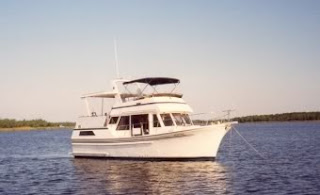Today I tow a 28 foot long, 12 foot high houseboat on a tandem axle trailer. I worry about having one of these phantom blowouts eventually resulting in my trailer getting out of control and the damage it can cause. My solution is to install a TPMS on my trailer.
Most new cars come with a TPMS. There are several varieties of 'aftermarket' TPMS systems. Most require demounting the tire and installing the sender inside the rim. It's not uncommon for these systems to require new senders when the battery powering it expires - this can be seven years or more...but still. Some work only when the vehicle is moving. Some have a range limited only to passenger car tire pressures. My original houseboat trailer tires called for 120 psi which is out of the range of many systems.
On my boat trailer, it would be nice to have the sender inside the tire when the trailer is in the water, and even thought I have a tire changer in my garage so I could do it myself, I still kept looking to explore other options. I came upon TST 507
I can possibly see why these units aren't more popular. The instructions are very intimidating! It turned out it wasn't all that bad once you get the hang of it...I think. I installed them on my one ton van to see how they work before I put them on the boat trailer. The sender just screws on the valve stem, but the receiver needs to be programmed to know which wheels have the senders and what psi and temp are associated with each.
So far, I'm extremely happy with my new TST 507 TPMS. The receiver will alarm if there's a blow out, slow leak or high temp. The receiver is battery powered as well as using a USB plug, so you can take it with you as you walk around the rig toggling thru the pressure and temp of each tire. With the receiver in hand, if you unscrew the sender from the valve stem (resulting in zero pressure), it will alarm with a blinking position - a great way to know the system is set up correctly and working.
I'll be a lot more comfortable this Fall when we tow Big Duck to Lake Powell (>2,000 miles each way) knowing that a bad tire will be detected in plenty of time to react safely. And by the way, did you know that no matter which tire blows, your safest move is to accelerate until you have control?











